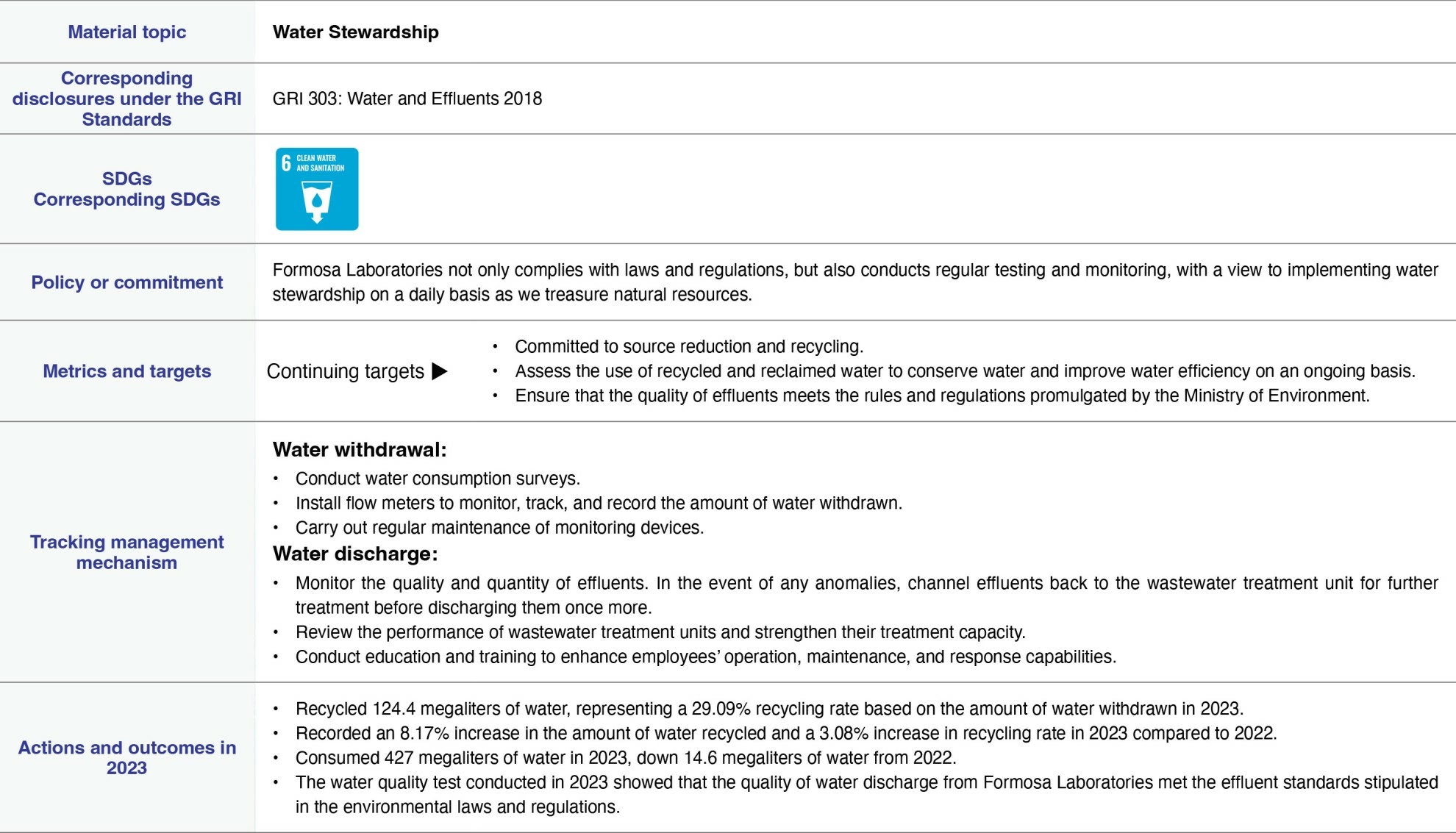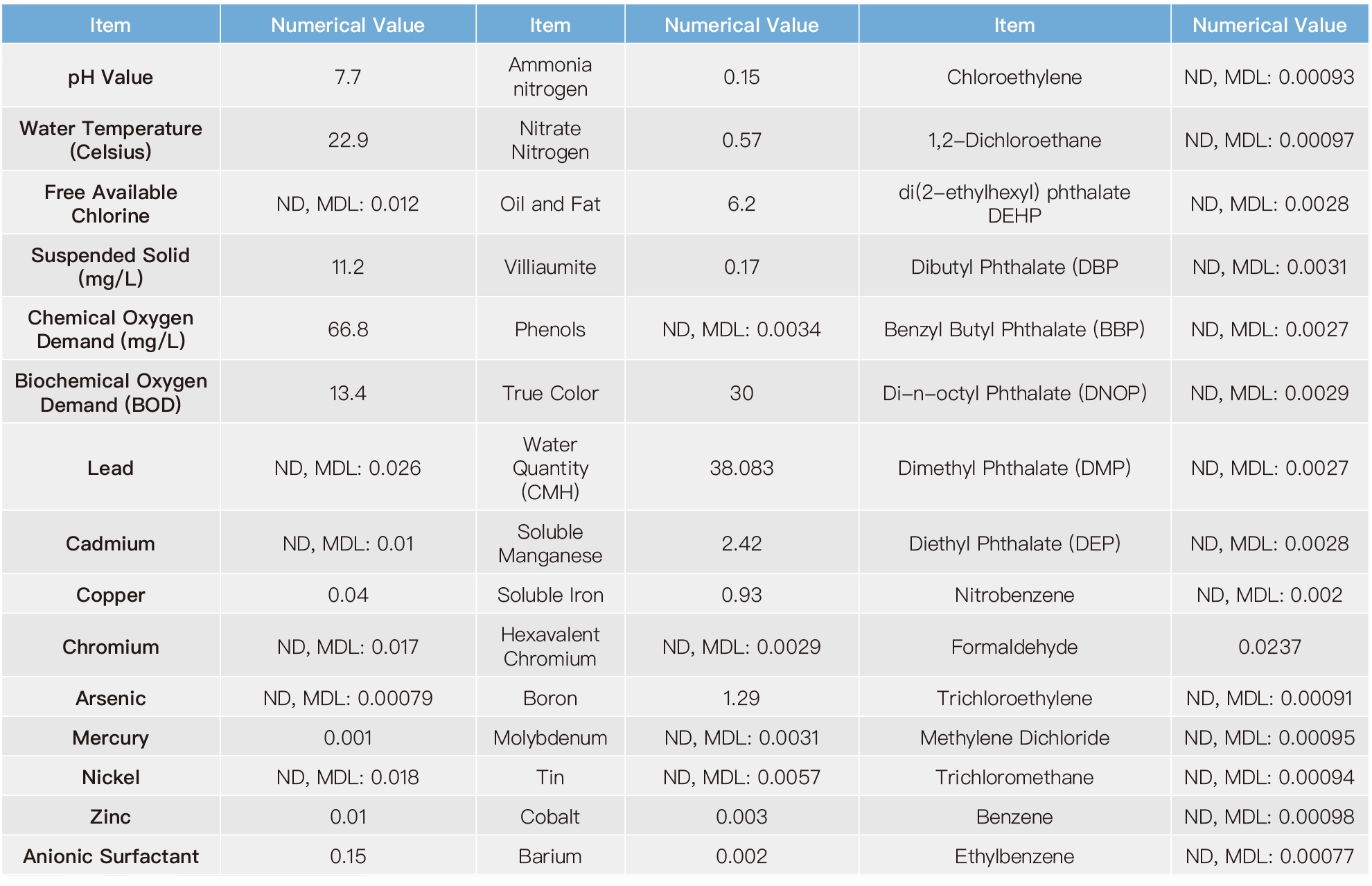Water Stewardship
▼Management of material topic “water stewardship” at Formosa Laboratories in 2023

Enhancing Water Efficiency
At Formosa Laboratories’ factories, manufacturing processes consume a higher amount of water, whereas domestic purposes make up the remaining proportion of water consumption. As the primary source of water at Formosa Laboratories is tap water, we also install flow meters to monitor, track, and record the amount of water withdrawn. Regular maintenance of monitoring devices is carried out to ensure correct and effective use of such information. Thanks to our ongoing efforts to conserve water and promote the use of recycled water over the past three years, Formosa Laboratories has experienced a gradual decline in water consumption, where the amount of water consumed by Formosa Laboratories dropped to 427 megaliters in 2023.
Following the introduction of a water recycling system since 2015, Formosa Laboratories has established a mechanism for recycling treated water for use in cooling waters, scrubbers, and vacuum systems. In 2023, Formosa Laboratories recycled 124.4 megaliters of water, representing a 29.09% recycling rate based on the amount of water withdrawn throughout the year. Formosa Laboratories recorded a 8.17% increase in the amount of water recycled and a 3.08% increase in water recycling rate in 2023 compared to 2022, indicating a significant and sustained improvement in water efficiency. In the future, we will continue to assess the water recycling system and its performance with a view to enhancing water efficiency.
▼Statistics on water consumption at Formosa Laboratories over the past three years (Unit: megaliters)
 Note:
Note:- Information on water withdrawal was taken from water bills, whereas water discharge was determined based on water meter records.
- The type of water withdrawn was fresh water, while the source of water withdrawal includes tap water from a third party. No surface water, groundwater, seawater or produced water was involved in water withdrawal at Formosa Laboratories.
▼Statistics on the amount of water recycled at Formosa Laboratories over the past three years (Unit: megaliters)

Minimizing the Impact of Water Discharge
Formosa Laboratories has set up wastewater treatment units to monitor and control the quality and quantity of effluents in accordance with the water quality items and limit values stipulated in the Effluents Standards promulgated by the Ministry of Environment. All the treated effluents are fresh water, which is discharged into the sea or lake ditches (surface water). Formosa Laboratories discharged 306.714 megaliters of water in 2023.
In 2023, Formosa Laboratories renovated the 600-metric-ton wastewater treatment plant. In an effort to accommodate growing water consumption due to increased production capacity, Formosa Laboratories has invested in improving the biological pool aeration system to enhance chemical oxygen demand (COD) reduction capabilities. As we regularly engage third-party organizations to conduct effluent quality testing, the water quality test conducted in 2023 showed that effluents discharged from Formosa Laboratories comply with the regulatory requirements.
Formosa Laboratories 2022 Material Topic: Innovative Research and Development
| Material Topics | Water Stewardship |
|---|---|
| Corresponding GRI indicators | GRI 303-1 Interactions with water as a shared resource GRI 303-2 Management of water discharge-related impacts GRI 303-3 Water withdrawal GRI 303-4 Water discharge GRI 303-5 Water consumption |
| Related SDGs | SDG 6 Clean water and sanitation |
| Policies or Commitments | Comply with laws and regulations and conduct testing and monitoring to implement daily water stewardship and cherish natural resources. |
| Indicators and Objectives | Sustainable Goals
|
| Effective Tracking Mechanism | Water withdrawal
|
| Annual Actions and Achievements |
|
Water Efficiency Improvement
According to the "World Resources Institute", 17 countries are facing the water resources crisis. While Taiwan is not a region facing water stress, its geographical conditions make retaining rainfall difficult. Furthermore, the booming industrial development has significantly increased water consumption. The sharing of water resources could pose a serious issue (the impact of supply-demand imbalance). Thus, it is essential to conserve water and improve water efficiency.
The primary water consumption in Formosa Laboratories' plants is for process water, with the remaining portion for service water, mainly sourced from tap water. Information on the company's water usage is gathered through a water usage survey, with flow meters installed to monitor and record water withdrawals. Regular maintenance of monitoring equipment is conducted to ensure the accuracy and effectiveness of the information. The total water withdrawal per year during the period from 2020 to 2022 ranged from 431 to 465 million liters. Although water consumption was higher in 2021, conservation and recycling efforts led to a decrease in water consumption to 442 million liters in 2022.
Formosa Laboratories' Water Consumption Statistics for the Past 3 Years

Note 1 : The water withdrawal and discharge are both based on water meters.
Note 2 : All water sources are fresh water; all water sources are third party tap water; no surface water, ground water, sea water, or produced water is used.
We promote water conservation measures, such as controlling the amount of water used in public restroom sinks, replacing old equipment with the faucets and toilets with Water Efficiency Label. In addition, since 2015, we have implemented a water recycling system and established mechanisms for using recycled water in cooling towers, scrubbing towers, vacuum systems, etc. The amount of recycled water has increased annually from 82.543 million liters in 2020 to 115.014 million liters in 2022. The rate has increased from 19.15% to 26.01%, indicating a significant improvement in water efficiency as it has increased by 6.86% over the past three years. In the future, we will review and improve water conservation measures to enhance water efficiency annually. We will assess and introduce various water recycling systems and methods to enhance efficiency.
Formosa Laboratories' Recycled Water Statistics for the Past 3 Years
(unit: million liters)


Mitigation of Water Discharge Impact
Formosa Laboratories is a biopharmaceutical company that operates a wastewater treatment unit. It monitors effluent quality and quantity in accordance with the "Effluent Standards" set by the Ministry of Environment (Table 4: Chemical Industry). If there is any abnormality in water quality, it is returned to the wastewater treatment unit for re-treatment and discharge; if there is any abnormality in water quantity, an investigation is conducted to identify the problem. The treated effluents are all freshwater and are discharged into the sea or lake ditch (surface water). The total discharge in 2022 is 331.540 million liters.
To improve operational processing capabilities and ensure the correct and effective use of information, regular reviews of the performance of the wastewater treatment plant and maintenance of monitoring equipment are conducted. In the following years, we will implement filter material replacements and aeration system updates, while continuously promoting education and training to enhance the operational, maintenance, and response capabilities of our employees. From 2020 to 2022, the effluent quantity decreased annually, primarily because of the increased recycled water. We outsource water quality testing for effluents biannually and consistently meet all legal requirements, and the test results in 2022 were all in compliance with regulations.
Formosa Laboratories 2022 Water Discharge Quality Test Results
